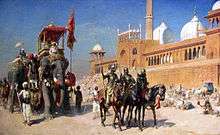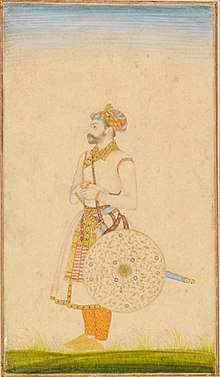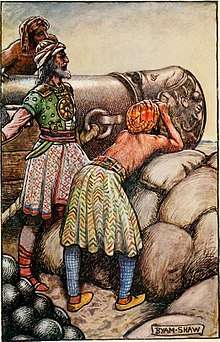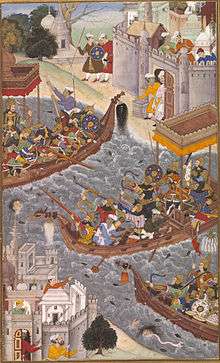Army of the Mughal Empire
| Mughal Army | |
|---|---|
 Flag of the Mughal Empire | |
 Great Mogul And His Court Returning From The Great Mosque At Delhi India - Oil Painting by American Artist Edwin Lord Weeks | |
| Founded | Late 15th Century |
| Disbanded | 1805 |
| Leadership | |
| Commander-in-Chief | Mughal emperor |
The Army of the Mughal Empire was the force by which the Mughal emperors established their empire in the 15th century and expanded it to its greatest extent at the beginning of the 18th century. Although its origins, like the Mughals themselves, were in the cavalry-based armies of central Asia, its essential form and structure was established by the empire's third emperor, Akbar.
The army had no regimental structure and the soldiers were not directly recruited by the emperor. Instead, individuals, such as nobles or local leaders, would recruit their own troops, referred to as a mansab, and contribute them to the army.
Origin
The Mughals originated in Central Asia. Like many Central Asian armies, the mughal army was horse-oriented. The ranks and pay of the officers were based on the horses they retained. Babur's army was somewhat small and looked like an army of Afghan origin. Akbar restructured the army and introduced a new system called the mansabdari system. Later emperors followed this system.
Organisation and troop types
Mughal emperors maintained a small standing army. They numbered only in thousands. Instead the officers called mansabdars provided much of the troops.
Standing army

The Mughal Emperors maintained small standing armies. The emperor's own troops were called Ahadis. They were directly recruited by the Mughal emperor himself, mainly from the emperor's own blood relatives and tribesmen. They had their own pay roll and pay master, and were better paid than regular hormen sowars.
They are gentlemen soldiers, normally on administrative duties in the palace. They also included palace guards, emperor's own body guards shahiwalas, and gatekeepers. They were better equipped and had their own horses.
The emperor also maintained a division of foot soldiers and had his own artillery brigade.
Mansabdars

Akbar introduced this unique system. The Mughal army had no regimental structure. In this system each officer worked for government was a military officer, responsible for recruiting and maintaining his quota of horsemen. His rank was based on the horsemen he provided, from ten, the lowest, up to 5000. A prince had the rank of 25000. This called as zat and sowar system.
An officer must keep a 1:2 ratio of men to horses. Horses must be carefully verified and branded, preferably an Arabian breed. He must also maintain his quota of horses, elephants and cots for transportation, as well as foot soldiers and artillery. Soldiers were paid in cash or jagir, cash paid for month to maximum one year, but many chose jagir. The emperor allocated jagir for maintenance of mansabs.
Branches
The Mughal army had no real divisions, though it had four types of warriors: cavalry, infantry, artillery and navy. The cavalry held the primary role, and the others were auxiliary.
Cavalry
.jpg)
The cavalry was the superior branch of the Mughal army. The horsemen normally recruited by mansabdars were high class people, and better paid than foot soldiers and artillery men. They must have at least two of their own horses and good equipment. Normally they used swords, lances, shields, more rarely guns. Their armour was made up of steel or leather, and they wore the traditional dress of their tribes. The regular horseman was called a sowar.

Mughal cavalry also included elephants, normally used by generals. They bore well ornamented and good armour. Mainly they were used for transportation to carry heavy goods and heavy guns. Some of rajput mansabdar provided camel cavalry also. They were men from desert areas like Rajastan.
Infantry
Emperors' Own infantry called as Ahsam. Mansabadars also provided infantrymen. They are normally ill-paid and ill-equipped. They lacked discipline. This group included bandukchi or gun bearers, swordsmen, as well as servants and artisans.
They used a wide variety of weapons like swords, shields, lances, clubs, pistols, rifles, muskets, etc. They normally wore no armour.
Artillery

It was an important branch of mughal army. Earlier mughal rulers made good use of it. It was used by babur to achieve an empire Hindustan.
Mughal artillery consisted of heavy cannons and light artillery. Heavy cannon were very expensive and very heavy for transportation. Used in battlefield was also somewhat risky. They were dragged by elephants to battlefields. They were slow to load and sometimes exploded, killing the crew members.

Light artillery was most useful in battle field. They were mainly made up of bronze and drawn with horses. This also included camel bear swivel guns. They were very effective in battlefield. But time to time the emperors show no interest in development of cannons. They became much out of date when used against European cannons built with iron.
Granadiers and raketies also came under this category.
Navy
It was the weakest and poorest branch of the Mughal military. The Empire did maintain warships, however they were relatively small. The fleet also consisted of transport ships. The Navy's main duty was controlling piracy, but they also were used in war.[1]
See also
References
- ↑ Roy, Atul Chandra (1972). A History of Mughal Navy and Naval Warfares. World Press.
Further reading
| Wikimedia Commons has media related to Military history of the Mughal Empire. |
- Edwardes, Stephen Meredyth; Garrett, Herbert Leonard Offley. Mughal Rule In India.
- Sharma, S. R. Mughal Empire in India: A Systematic Study Including Source Material.